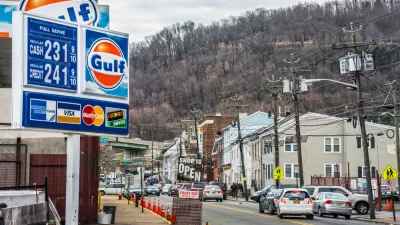California's cap-and-trade market saw its largest carbon sale, $1.02 billion, thanks to millions of motorists now paying about a dime a gallon for the right to emit carbon for the first time since the program began in November 2012.
"Companies spent more than $1 billion in California’s latest sale of carbon emissions credits, making it the largest auction since the controversial cap-and-trade program began in late 2012, state officials said (Feb. 25)," writes business and economics reporter, Dale Kasler for The Sacramento Bee.
The reason: State officials dramatically expanded the pool of credits for sale to accommodate a surge in demand. That became necessary because the cap-and-trade market has been broadened since Jan. 1 to cover the carbon coming from motor vehicle tailpipes.
One credit = allowance to emit one ton of carbon. In other words, the "carbon externality" is history in California thanks to the only state cap-and-trade program in the United States. One clarification: the carbon charge is paid by wholesale fuel suppliers who presumably pass on the charge (derided by opponents who called it a 'hidden gas tax'), about a dime a gallon, to fuel retailers.
Kasler describes the mechanics of the February 18 carbon auction. The Air Resources Board "dramatically increased the volume of available credits...to limit the impact on consumers." Consequently, the price was in line with prior auctions: $12.10 per credit.
Quebec now in California program: "Last week’s auction was the second sale held jointly with the Canadian province of Quebec," writes Kasler. "Credits purchased in California can be used to emit carbon in Quebec, and vice versa."
The California program differs from Washington State proposal: As noted here and here, Gov. Jay Inslee (D-Wash.) proposed a carbon tax to pay for transportation infrastructure. However it would be applied to industrial, not tailpipe emissions. It also differs from the California program where revenue from the sale of carbon allowances are required to be spent on programs to reduce carbon emissions, e.g., high speed rail, public transit, and the new Affordable Housing and Sustainable Communities program.
Writing on another carbon pricing strategy proposed for Oregon, the carbon tax, or more specifically, the carbon tax and dividend, Streetsblog's Angie Schmitt describes the plan proposed by Oregon Climate that would tax "wholesale fossil-fuel transactions" and rebate all revenue to citizens rather than applying it to carbon-reducing activities as is done in California. "The carbon tax would need to secure a majority of the popular vote and 60 percent of the state legislature to be enacted," she notes in a correction.
Hat tip to Jackie@Climate Plan.
FULL STORY: Companies spend $1 billion in latest California carbon auction

Alabama: Trump Terminates Settlements for Black Communities Harmed By Raw Sewage
Trump deemed the landmark civil rights agreement “illegal DEI and environmental justice policy.”

Planetizen Federal Action Tracker
A weekly monitor of how Trump’s orders and actions are impacting planners and planning in America.

The 120 Year Old Tiny Home Villages That Sheltered San Francisco’s Earthquake Refugees
More than a century ago, San Francisco mobilized to house thousands of residents displaced by the 1906 earthquake. Could their strategy offer a model for the present?

Opinion: California’s SB 79 Would Improve Housing Affordability and Transit Access
A proposed bill would legalize transit-oriented development statewide.

Record Temperatures Prompt Push for Environmental Justice Bills
Nevada legislators are proposing laws that would mandate heat mitigation measures to protect residents from the impacts of extreme heat.

Downtown Pittsburgh Set to Gain 1,300 New Housing Units
Pittsburgh’s office buildings, many of which date back to the early 20th century, are prime candidates for conversion to housing.
Urban Design for Planners 1: Software Tools
This six-course series explores essential urban design concepts using open source software and equips planners with the tools they need to participate fully in the urban design process.
Planning for Universal Design
Learn the tools for implementing Universal Design in planning regulations.
Clanton & Associates, Inc.
Jessamine County Fiscal Court
Institute for Housing and Urban Development Studies (IHS)
City of Grandview
Harvard GSD Executive Education
Toledo-Lucas County Plan Commissions
Salt Lake City
NYU Wagner Graduate School of Public Service




























